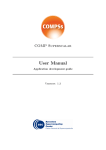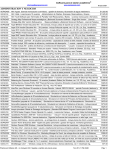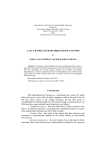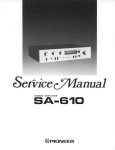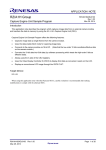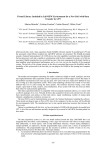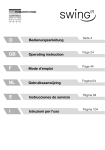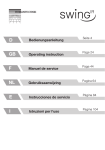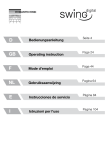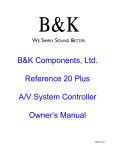Download etc.tuiasi.ro
Transcript
THE PUBLISHING HOUSE OF THE ROMANIAN ACADEMY PROCEEDINGS OF THE ROMANIAN ACADEMY, Series A, Volume 10, Number 2/2009, pp. 000–000 EEG CLASSIFICATION SYSTEM – FROM AN UNIVERSAL SYSTEM IMPLEMENTATION TO A PARTICULAR SIGNAL MODELING Dan-Marius DOBREA, Monica-Claudia DOBREA Technical University of Iasi, Iasi, Romania Corresponding author: Dan-Marius DOBREA, [email protected] One of the main goals of our research is the implementation of a new algorithm able to interpret the EEG signals within a real time brain-computer interface (BCI) system. Also, in this paper we propose a new design for the BCI systems, based on the concept of dynamic modularity. The prototype of the bio-instrumental system, made on this new introduced concept, enables a fast implementation of various types of algorithms, the estimation of different parameters of the algorithms and, also, a realtime implementation and testing of these algorithms. In order to test the system we used two different paradigms: a classical approach (based on an AR model and a neural network) and a new proposed feature extraction method, followed by a neural classifier. The new proposed signal model, named Adaptive Nonlinear Amplitude and Phase Process (ANAPP) Model, uses an amplitude and phase adaptive technique in order to model the EEG signals. Another specificity of the ANAPP model is that some nonlinear spectral characteristics of the brain system are explicitly integrated in the model. Key words: Brain computer interface, EEG signal, adaptive algorithms, neural networks 1. INTRODUCTION Brain computer interface (BCI) systems presented in the literature (e.g. [1], [2], [10]) process only one or few particular activities of the central nervous system and in only one or few particular ways; thus, for different paradigms, diverse specific processing ([1], [5], [8], etc.) and classification methods ([1], [4], [5], [6], [7], etc.) are employed. The solutions reported in the literature (e.g. for artifacts suppressing algorithms, for algorithms extracting the features data sets, or for classifier systems) are of rare encountered diversity; this and the large diversity of paradigms used makes almost impossible to systematically and objectively evaluate and compare the reported results. Thus, it appeared the necessity for an universal BCI system (e.g. [1], [2]) which to facilitate a quick and in real-time implementation and test of different paradigms and algorithms. However, the actual general BCI platforms proposed are either not complete (e.g. [1]) or not optimal solutions (e.g. [2]). In this paper we propose and implement a new development platform for the BCI applications based on the dynamic modularity concepts. Two different analyzing paradigms were employed. The first analysis (implementing a classical EEG task classification [3] methodology) was mainly aimed to test the concepts and the characteristics of the new introduced system and not necessarily to obtain superior classification performances. In the second analysis, a new method for EEG signal modeling was proposed and tested on the new introduced BCI platform. In this way, we investigated both: the characteristics of our BCI system (fast system implementations ability, flexibility, dynamic modularity etc.) and the classification performances obtained with the new feature extraction technique (namely, ANAPP model). 2. SYSTEM IMPLEMENTATION In order to implement and test various types of algorithms quickly and in real-time, the new platform for the BCI system had to present the following main characteristics: (a) flexibility and an independent operating mode – the system had to be able to work with different types of methods and algorithms, Dan-Marius DOBREA, Monica-Claudia DOBREA 2 combined in different structures, without the modification of those parts of the system that were not directly related to them (b) scalability – no restrictions on the number of channels and on the magnitude of the data sets, (c) ability to work online, to process in real time the acquired signals, (d) ability to analyze the data sets offline, (e) autonomy, given by the possibility of the system to be mounted on a mobile device – in this case, restrictions regarding the system’s power consumption and the computational costs had to be considered. S ystem co nfig uration and data visu alizatio n F ram e level app lication System output Information Postprocessing Classification Feature Extraction Signal preprocessing Data storage EEG acquisition system C om po nents S in cro nisatio n O utp ut lin es M on itor S erial P o rt U SB Figure 1. The schematics of the new BCI system 2.1. System implementation The main concept of the new platform is the dynamic modularity of the entire BCI system; namely, each module can be independently modified, changed, loaded (by the frame level of the application) and, finally, transparently used by the system without any BCI platform re-initialization. The system’s user needs to understand only the inter-module communication (no supplementary knowledge regarding the architecture or the algorithms used in the rest of the system is necessary). Thus, one can focus only on the development of a single module (that embeds one single algorithm), disregarding the other algorithms embedded in the other modules. By this approach an abstraction of the global working principle of the system is obtained. All user-defined modules are implemented based on the shared library concept (introduced by Microsoft), known under the name of Dynamic Link Libraries (DLL). The BCI system can manage and use the following user-defined modules: EEG acquisition, data storage, signal pre-processing, feature extraction, classification, post-processing and output command, Figure 1. Each module consists of simple functions that define its unique functionality. These functions receive the addresses of the working data arrays, as well as the information regarding their dimensions and return other data arrays and their dimensions. Since all these DLLs can be implemented in different programming languages and developing environments (e.g. LabWindos CVI, Visual C++, LabVIEW, Borland C++ Builder, Visual Basic, Borland Delphi etc.), the independence of the system is achieved not only through the independence of the modules (given by their different possible combinations that can be chosen in order to solve a problem), but also through the liberty one has in choosing the desired development environment when designing the modules. The frame level of the BCI system can dynamically load (explicitly link) or discard the DLLs without restarting the whole BCI system. The data transfer between the modules is based on data arrays (vectors). Mainly, because the BCI applications are data-intensive and computing-intensive, the frame level component of the system, Figure 1, was built to be as less as possible expensive (in both data and computing). From this reason, the roles of the frame level application were limited to: load/unload the DLL modules, dynamically allocate the data arrays, to communicate from one function to another the addresses of the data and their dimensions and, whenever is necessary, to fire the exported functions from the DLLs. In order to correctly interact with the BCI platform each module consist of a number of functions that have standard names, namely: exemplarStart_**** (executed before each feature vector is presented to the classification module), epochStart_**** (the function is fired up before each epoch is started), moduleReset_**** (used when the frame level application resets the entire system), moduleInit_**** ( fired up in order to initialize each particular module), modulePerform_**** (the function implements the main functionality of the module), moduleFree_**** (discards all data that were previously dynamically allocated in the DLL) and moduleInfo_**** (that supplies different particular information regarding the state and the functionality of a module). The “****” symbol represents a specific name associated with each specific 3 EEG Classification System – From an Universal System Implementation to a Particular Signal Modeling module – “Input” for the acquisition module, “PreProc” for the signal preprocessing module, “FeatureExt” for the functions associated with features extraction block, “Classif” for the classification module, “PostProc” and “Output” for the post-processing and, respectively, output modules. Each module consists only of those specific functions required to implement its particular necessities and functionalities. Each time a DLL is loaded by the frame level of the application into the virtual address space of the current process, the moduleInit_**** is also executed; thus the DLL can initialize any instance of data and structures. The moduleInit_**** function has two meanings: it initializes the module and returns to the frame level of the application an integer value that is directly correlated with the number and the specific types of the functions implemented into the DLL. Based on these initializations the functionality of the entire module is settled. 3. TESTING PARADIGMS Up to now, we implemented and fully tested the frame level of the new general BCI system using some specific types of algorithms and a particular system structure (consisting in signal preprocessing, features extraction, classification and system output modules). The EEG acquisition system and the corresponding software module were simulated using a DLL that loaded files previously stored on the hard disk. For the tests we used the EEG database freely provided by the Colorado State University [10]. The EEG signals were simultaneously recorded from 6 scalp electrodes (C3, C4, P3, P4, O1, and O2). During the recordings the 4 involved subjects performed (without verbalization and with eyes closed) the following imaginary mental tasks: mental relaxation, writing, mathematic calculus (multiplication), visual counting and rotation of a geometric figure. The sampling frequency was 250 Hz and each recording lasted 10 s. For all tests the classification module was a one hidden-MLP type neural network. The networks used in this research were developed, built, tested and implemented using the NeuroSolution software package. 3.1. Dynamic modular BCI system The main aim of this first investigation was to test the EEG bio-instrumental system in a well study framework, based on classical algorithms, and not to obtain the best performances in the BCI field. In this context, two different experiments were carried out. First, we tested the functionality of our new BCI system by comparing the obtained results with [3] (same methods were used in both systems). Second, we tested the dynamic characteristic of the BCI platform by using the same modules for the bio-instrumental system, with the exception of the classification module, for which two distinct MLP networks were successively used. In order to classify the five mental tasks we used the same approach as presented in [3]. For each channel, six AR (auto-regressive) coefficients were extracted using the Levinson-Durbin recursive algorithm on a sliding window of 128 samples, overlapped by 50%. The resulting feature vectors of 36 elements were used as input for the MLP network. The classification results obtained with our BCI platform (see Table 2) are comparable with the ones presented in [3]. This first analysis proved the functionality of each module and, more important, the functionality of the BCI frame level (protocols and the functionality concept). Table 2. Performances obtained on the cross-validation set [9] Baseline Count Letter Math Rotate Assigned Classes Baseline 39.2% 30.5% 18.1% 9.2% 3.0% Count 22.3% 62.4% 0% 13.1% 2.2% Letter 5.2% 6.1% 55.3% 19.3% 14.1% Math 4.2% 5.3% 14.1% 75.0% 1.4% Rotate 17.3% 14.2% 6.1% 6.1% 56.3% Real Classes In the second step, the feasibility of the dynamic modularity concept of the BCI system was tested. First, a suboptimal ANN was built and trained (using NeuroSolutions); when a good result was achieved, it was implemented into a specific classification module. This ANN had the same dimensionality Dan-Marius DOBREA, Monica-Claudia DOBREA 4 of the input feature space like the optimal neuronal structures presented above. In this test, we accomplished some very simple actions such as: stopping the execution of the system, removing the existing classification module, loading the new module and restarting the system; all actions were performed from the frame level user interface panel. In the same time, all other modules, together with the entire system settings, remained the same. Thus, by exploiting the characteristic of dynamic modularity of the entire system, the behavior of the BCI system was successfully dynamically changed, without recompiling the entire application. Another ANN classifier was also implemented into the classification module. This time, the input feature space was larger than for the first implemented ANN; that is, eight auto-regressive coefficients were now extracted for each channel instead of six. The steps required to dynamically implement the new structure resided in loading the new neuronal classifier, and in changing the dimensionality parameters of the data matrix representing the data flow between the features extraction DLL and the classification DLL. The classification module of the BCI system and the working parameters for this module and for the feature extraction module had to be changed accordingly by the user; in this way, the initialization parameters for both modules were put in a correct correspondence. The result of this new test was, also, a very good one. As a conclusion, the BCI bio-instrumental system platform proved its capability to both interpret the EEG activity of the brain and to implement fast and easy different paradigms and EEG analyzing methods. 3.2. ANAPP model For the second analysis, we used the same EEG database. In a first attempt to classify the five mental tasks, the EEG signals were modeled using an Adaptive Nonlinear Markov Process Amplitude (ANMPA) method presented in [11]. Due to a series of drawbacks of this modeling technique we derived an improved version of ANMPA method (presented in [12]). We will name to this model Adaptive Nonlinear Amplitude and Phase Process (ANAPP) model in the rest of the paper. The spontaneous cortical oscillations a priory required by the model were derived by using the coherence function. The parameters obtained from the ANAPP model were then used as input data for a MLP who finally provided the correct classification rate. The coherence function In the ANAPP model the spontaneous oscillations are a priory required. In our case, these oscillations ^ were determined by using the coherence function, R xy (λ ) , calculated with the general formula: 2 2 Rxy (λ ) = fˆxy ( λ ) ( fˆ ˆ xx ( λ ) f yy ( λ ) ) (1) The coherence function indicates the degree of linear correlation, in the frequency domain, between the two analyzed signals, x and y. In order to obtain the formula for the coherence function we first divided each of the two investigated time series into L overlapping windows of length T. Time series data from each window were Fourier-transformed. The Fourier-transformed was calculated for x – the first trial for each subject, each task and each EEG channel – and then, for y – the second trial for the same subject, task and channel. The line is the confidence limit assessed at the 95% level Figure 2. The user interface used in coherence computation [12] ^ ^ ^ Next, auto-, f xx (λ ) , f yy (λ ) , and cross-spectra, f xy (λ ) , were further estimated by averaging over the 5 EEG Classification System – From an Universal System Implementation to a Particular Signal Modeling overlapped sections. To facilitate the interpretation we calculated the pooled coherence estimate, whose values domain and interpretation are similar to the coherence estimate [22]. Also, as in [22], we calculated a statistical test and a confidence limit that was set at the 95% level. Values of the pooled estimate of coherence lying below this line could be taken as evidence that, in average, no coupling occurred between the two processes (x, y) at the particular frequencyλ. Adaptive Nonlinear Amplitude and Phase Process Model An adaptive nonlinear amplitude and phase model was implemented to model the EEG data sets. The EEG signals were assumed to be suitably decomposed by the EEG model into some spontaneous oscillations (a priory specified) and their corresponding nonlinearly coupled frequencies (self-coupling oscillations and, respectively, cross-coupling oscillations). From the theoretically and practically point of view two oscillatory waves (of f1 and f2 frequency), passing through a nonlinear system, generates two kinds of harmonic frequencies: self-coupling harmonics (2·f1 and 2·f2) and, respectively, cross-coupling harmonics (f1 ± f2). In a first implementation the EEG signal was modeled using an adaptive nonlinear Markov process amplitude (ANMPA) model, see relation (6). In (6) y[n] is the estimated EEG signal assumed to be composed of K different fundamental oscillations (xj, j=1÷K) and their related self-coupling and, respectively, cross-coupling oscillations, TS is the sampling rate, fj is the dominant j-th frequency, φj is the associated phase (which was set to zero, being unused in [11]), εsj is the self-coupling coefficient of the j-th model oscillation, εc1ij and εc2ij are the cross-coupling coefficients of the coupled frequency (fi - fj and fi + fj), n is the time index and aj[n] is the model amplitude of the first order Markov process. [ ] K K ⎧ ⎪ y [n ] = ∑ a j [n ]x j [n ] + ∑ ε sj a j [n ]α j [n ] + ∑ ε ijc1 a i [n ]a j [n ]β ij [n ] + ε ijc 2 a i [n ]a j [n ]θ ij [n ] ⎪ j =1 j =1 i , j = 1, K ⎪ i≠ j ⎪ x j [n ] = sin n ⋅ T S ⋅ 2π ⋅ f j + φ i ⎪ ⎛ ⎞ ⎪ ⎜ ⎟ ⎨ [ ] α n sin n T 2 π 2 f φ = ⋅ ⋅ ⋅ + ⎜ i S j ij ⎟ ⎪ N ⎜ ⎟ ⎪ fi ⎝ ⎠ ⎪ β ij [n ] = sin n ⋅ T S ⋅ 2π ⋅ ( f i − f j ) + φ ij ⎪ ⎪ ⎪ θ ij [n ] = sin n ⋅ T S ⋅ 2π ⋅ ( f i + f j ) + ϕ ij ⎩ ( ) [ ] [ ] (2) All parameters of the model (aj, γj, μj, εsj, εc1ij and εc2ij) were adaptively determined with the least mean square (LMS) algorithm [11]. The squared instantaneous error, e[n]2 = (s[n]-y[n])2 (where s[n] is the real EEG signal), was used as an estimate of the mean square error cost. Thus, the calculus relation for the next estimate of the model amplitude, aj[n+1], was : a j [n + 1] = γ j [n ]⋅ a j [n ] + μ j [n ]⋅ ξ j [n ] (3) Here, μj is the coefficient of the random process, γj is the coefficient of the first-order Markov process (0<γj<1) and ξj[n] is the independent increment of Gaussian distribution, with zero mean and unity variance. After a series of tests and analyses we concluded that the ANMPA model had several major drawbacks. The most limitative disadvantage was generated by the model poor convergence characteristics (a large number of ANMPA runnings were necessary to obtain the minim approximation error). Moreover, no objective criterion to choose the best solution could be determined. These facts are very limitative constrains for a BCI system, making the real time operating characteristics of the system to be unpredictable. To overcome these drawbacks a new model, namely ANAPP model, was introduced. In ANAPP, unlike the ANMPA model, the estimated EEG signal, y[n], was given by equation (4); in addition, the phases of the fundamental oscillations, of the self-coupling and cross-coupling harmonics were adaptively find out (14). y [n ] = K L m =1 m =1 M N P Q ∑ a m [n ] x m [n ] + ∑ b m [n ] α m [n ] + + ∑ ∑ c lm [n ] β lm [n ] + ∑ ∑ d lm [n ]θ lm [n ] l =1m =1 l≠m The LMS formulas for the ANAPP model parameters are similar: l =1m =1 l≠m (4) Dan-Marius DOBREA, Monica-Claudia DOBREA φ j [n + 1] = φ j [n] − η φ j 6 ⎧1 ⎫ ∂ ⎨ e 2 [n]⎬ ∂y[n] ⎩2 ⎭ = φ j [n] + η φ j e[n] = φ j [n] + η φ j e[n] a j [n] cos( n ⋅ Ts ⋅ 2 π ⋅ f j + φ j ) ∂φ j [n] ∂φ j [n] (5) ⎧1 ⎫ ∂ ⎨ e 2 [n]⎬ ⎩2 ⎭ = a j [n ] + η a j e[n] x j [n], ∂ a j [n] (6) a j [n + 1] = a j [n] − η a j We make the remark that for the bj, cij and dij parameters the corresponding pairs for (ηaj,xj) are (ηbj, αj), (ηcij, βij) and, respectively, (ηdij, θij). The quantities ηaj, ηbj, ηcij and ηdij are positive scalars, named learning rates, and they control the convergence rate and ensure the stability of the model. Real EEG signal – time domain [samples] Modeled EEG signal – time domain [samples] Spectrum of the real EEG signal [Hz] Spectrum of the modeled EEG signal [Hz] Training error [epochs] EEG spontaneous frequency values [Hz] Figure 3. The user interface for the ANAPP model software The most important advantage of the ANAPP model is given by its superior convergence characteristics. Actually, the model is able to converge to the optimal solution in no more than 30 sampling intervals (see Figure 3). Also, the computational complexity of the new model for updating an estimated parameter is very low (no more than four multiplications for each sampling interval). Both software applications, presented in Figure 2 and Figure 3, were developed in LabWindows CVI environment. Artificial Neural Networks (ANNs) The calculated amplitude coefficients of the ANAPP model were taken as components for the ANN input feature-vectors. We chose for the classification system an one hidden-multilayer perceptron (MLP) network. The ANN was trained with the backpropagation algorithm [13] and it had 104 inputs, 40 processing elements (PE) on the hidden layer and 4 or 5 PEs on the output layer. The different number of the output PEs corresponded to the two distinct classification problems – with 4 and, respectively, 5 different mental tasks. Since, the second goal of our study was to test the performances of the new implemented feature extraction technique, namely ANAPP model, in comparison to other feature extraction techniques, no other neural structures were tested in this stage. Results For this analysis we considered only one subject, namely, subject 2, which was reported in the literature as having the greatest performances in comparison with the other three subjects also investigated. 7 EEG Classification System – From an Universal System Implementation to a Particular Signal Modeling A sliding window of 512 samples, overlapped by 95%, was used to obtain the values for the coherence function for each pair of records acquired from the same electrode and for the same task. Based on the displacement of the sliding window (25 samples or, equivalent, 100 ms) we intimately followed the course of the cortical activity transitions, considered to happen within time intervals of hundred of milliseconds. The fundamental frequencies for the ANAPP model, used in the EEG signal reconstruction, were different for each recording channel and given by five different frequencies (the frequencies with the greatest coherence values obtained for the five mental tasks). All selected frequencies were from the gamma band. This fact comes to emphasize the importance of the high frequencies band that, until recently, was considered not carrying any useful information. Nowadays, there are researches that sustain this new innovative idea [14], [15]. According to this aspect and knowing that, usually, the most part of the EEG signal energy is situated in the 0 – 20 Hz band (making thus difficult to obtain a reliable EEG ANAPP model), we pre-filtered the signals before the modeling phase. Correspondingly, we revised the initial soft for the model (we forced the learning rates and the initial amplitudes values to become zero for those derived frequencies within 0 – 20 Hz band or over the half of the sampling frequency). By removing the frequency components of zero value parameters, the feature vectors were reduced from180 to only 104 components. Finally, we got 1670 input feature vectors (167 vectors/each recording * 2 recordings * 5 mental tasks). The feature vectors were achieved by concatenating only the amplitude parameters of the ANAPP model; these amplitude parameters were obtained for EEG sliding windows of 256 samples length, simultaneously recorded from the all six channels. From this dataset we used 80% data for the training set and 20% data for the cross validation set. The results achieved for the two cases (4 and 5 mental tasks classification problems) are given in Table 3 and, respectively, in Table 4. The obtained correct classification rates were, in average: for the 5 tasks problem around 70% (each classification rate being greater then 64%, see Table 4) and for the 4 tasks problem around 78.275% (with all rates being greater then 72%, see Table 3). These results are superior to the other results reported in the literature on the same EEG database. Thus, in [16] the average percentage of test segments correctly classified ranged from 71% for one subject to 38% for the worst case. But, the 71% correct classification performance was artificially improved within a post-processing stage when averaging across 20 consecutive segments was performed, the real value being in fact 54%. Rotate Rotate 10.9 7.3 3 72.1 Math 6.3 5.7 77.3 2.9 Letter 3.2 84.1 13.6 10.3 Assigned Classes Real Classes Baseline Count Letter Math Rotate Count 79.6 2.9 6.1 14.7 Table 4. The confusion matrix for the 5 tasks classification case, in percents [12] Baseline Count Letter Math Rotate Math Real Classes Letter Assigned Classes Count Table 3. The confusion matrix for the 4 tasks classification case, in percents [12] 65 11.9 7.6 8.3 7.3 15 64.2 3.9 8.3 7.3 5 3.1 78.5 10 11.8 8.3 8.9 6.3 70 1.5 6.7 11.9 3.7 3.4 72.1 4. CONCLUSIONS Unlike other general BCI platforms proposed in the literature like the BCI system proposed in [1] or the BCI2000 system [2], our BCI platform is a complete solution, covering all the imposed requests. Thus, all tests performed with the new developed EEG bio-instrumental system demonstrated: the dynamic modularity of the entire system, its flexibility and independent operating mode, the ability to process in real time the EEG signals and, also, the simplicity of the idea that generates low data-intensive and computingintensive burden at the frame level of the application. In particular, the independence of the system, due to the DLLs usage, overcomes the drawback of the system in [1] for which an external compiler is necessary when writing the critical software blocks. Moreover, due to the simple inter-modules communication algorithm, the understanding level of the concepts that underlie the system platform communication is Dan-Marius DOBREA, Monica-Claudia DOBREA 8 minimum, thus facilitating the implementation of any specific method and increasing the system working speed comparing with the TCP/IP layer of communications presented in the other modular system [2]. All system capabilities mentioned above facilitated an easy and quick comparison of the mental tasks classifications results obtained with different methods; in this mode, the new BCI platform effectively assisted us in the best method selection process. The new method for EEG features extraction presented in this research, namely the ANAPP model, generated a clear improvement in the BCI field. Unlike the other classical techniques used in the EEG preprocessing and processing stages, the ANAPP method brings into discussion and explicitly integrates into the model some nonlinear brain functioning aspects. In comparison with [11], our model took in consideration also the phase information. The adaptive algorithm used in ANAPP model had superior convergence characteristics than the one associated with the ANMPA model [11]. Also, a key feature of the method resides in the way the a priori specified frequencies were objectively extracted, based on the coherence function. The coherence function is a measure of the EEG synchronicity and it has been shown to be very useful for measuring changes in the EEG topography related to cognitive tasks. The objectively derived frequencies were frequencies from the high gamma frequency band. Nowadays, the new innovative idea of the high frequency band carrying useful information is already sustained by the preliminary results of some other studies [14], [15]. As a conclusion, both, the new dynamic modular BCI system design and the EEG coherence based ANAPP method – which was proposed as a candidate for the EEG feature extraction methods – confirmed, through the presented tests, their validity and, respectively, very good performances. REFERENCES 1. 2. 3. 4. 5. 6. 7. 8. 9. 10. 11. 12. 13. 14. 15. 16. GUGER, C., SCHLÖGL, A., NEUPER, C., WALTERSPACHER, D., STREIN, T., PFURTSCHELLER, G., Rapid prototyping of an EEG-based brain-computer interface (BCI), IEEE Transactions on Neural Systems and Rehabilitation Engineering, 9, 1, pp. 49-58, 2001. SCHALK, G., MCFARLAND, DJ., HINTERBERGER, T., BIRBAUMER, N., WOLPAW, JR., BCI2000: a general-purpose brain-computer interface (BCI) system, IEEE Transactions on Biomedical Engineering, 51, 6, pp. 1034-1043, 2004. MAIORESCU, VA., DOBREA (ŞERBAN), MC., LAZAR, AM., Classification of EEG Signals Represented by AR Models for Cognitive Tasks – a Neural Network Based Method, International Symposium on Signal Circuits and System, 2, Iasi, Romania, pp. 441-444, 2003 DOBREA (ŞERBAN) MC., DOBREA, DM., Discrimination between cognitive tasks - a comparative study, International Symposium on Signals Circuits and Systems, 2, Iaşi, România, pp. 805-808, 2005. RON-ANGEVIN R., DÍAZ-ESTRELLA A., Brain–computer interface: Changes in performance using virtual reality techniques, Neuroscience Letters, 449, 2, pp. 123-127, 2009. MASON SG., BIRCH GE., A general framework for brain-computer interface design, IEEE Transactions on Neural Systems and Rehabilitation Engineering, 11, 1, pp. 70-85, 2003. MILLÁN, JR., RENKENS, F., MOURIÑO, J., GERSTNER, W., Noninvasive Brain-Actuated Control of a Mobile Robot by Human EEG, IEEE Transactions on Biomedical Engineering, 51, 6, pp. 1026-1033, 2004. WEI, Q., WANG, Y., GAO, X., GAO, S., Amplitude and phase coupling measures for feature extraction in an EEG-based brain-computer interface, Journal of Neural Engineering, 4, 2, pp. 120-129, 2007. DOBREA DM., DOBREA MC., An EEG (Bio)Technological System For Assisting the Disabled People, 5th International Conference on Computational Cybernetic, Gammarth, Tunisia, pp. 191-196, 2007. EEG data base, http://www.cs.colostate.edu/~anderson/, 2000. AL-NASHASH, H., AL-ASSAF, Y., PAUL, J., THAKOR, N., EEG Signal Modeling Using Adaptive Markov Process Amplitude, IEEE Transactions on Biomedical Engineering, 51, 5, pp. 744-751, 2004. DOBREA, DM., DOBREA MC., COSTIN, M., An EEG Coherence Based Method Used for Mental Tasks Classification, 5th International Conference on Computational Cybernetics, Gammarth, Tunisia, pp. 185-190, 2007. HAYKIN S., Neural Networks – A comprehensive Foundation, New Jersey, USA, Prentice-Hall Inc., 1999. LIU, H., WANG, J., ZHENG, C., HE, P., Study on the Effect of Different Frequency Bands of EEG Signals on Mental Tasks Classification, 27th Annual Conference of IEEE Engineering in Medicine and Biologz, Shanghai, China, pp. 5369-5372, 2005. PALANIAPPAN, R., Utilizing Gamma Band to Improve Mental Task Based Brain-Computer Interface Design, IEEE Transactions on Neural Systems and Rehabilitation Engineering, 14, no. 3, pp. 299-303, 2006. ANDERSON, CW., SIJERČIĆ, Z., Classification of EEG Signals from Four Subjects During Five Mental Tasks, Conference on Engineering Applications in Neural Network, pp. 407-414, 1996. Received February 17, 2009









